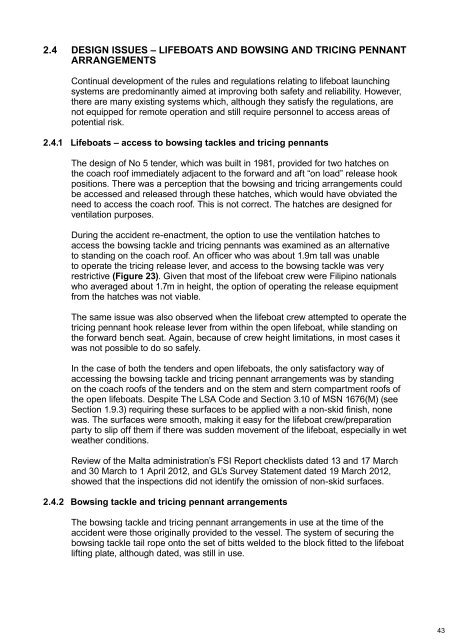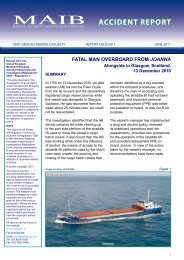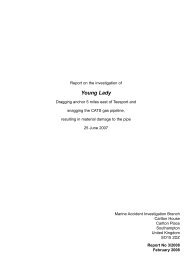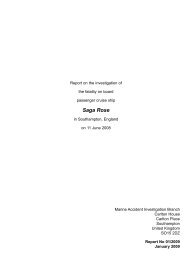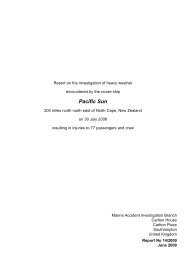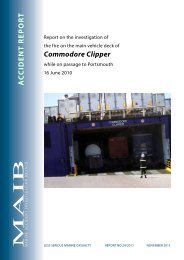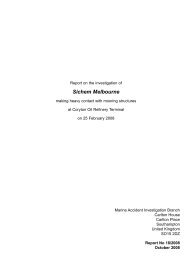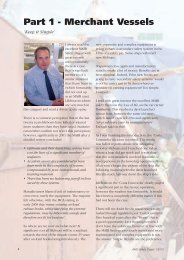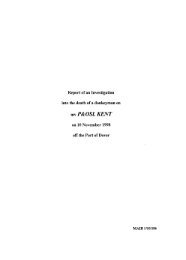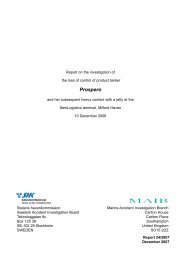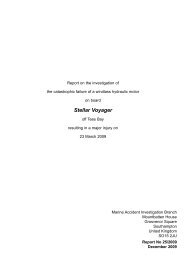SECTION 4 - Marine Accident Investigation Branch
SECTION 4 - Marine Accident Investigation Branch
SECTION 4 - Marine Accident Investigation Branch
You also want an ePaper? Increase the reach of your titles
YUMPU automatically turns print PDFs into web optimized ePapers that Google loves.
2.4 DESIGN ISSUES – LIFEBOATS AND BOwSING AND TRICING PENNANT<br />
ARRANGEMENTS<br />
Continual development of the rules and regulations relating to lifeboat launching<br />
systems are predominantly aimed at improving both safety and reliability. However,<br />
there are many existing systems which, although they satisfy the regulations, are<br />
not equipped for remote operation and still require personnel to access areas of<br />
potential risk.<br />
2.4.1 Lifeboats – access to bowsing tackles and tricing pennants<br />
The design of No 5 tender, which was built in 1981, provided for two hatches on<br />
the coach roof immediately adjacent to the forward and aft “on load” release hook<br />
positions. There was a perception that the bowsing and tricing arrangements could<br />
be accessed and released through these hatches, which would have obviated the<br />
need to access the coach roof. This is not correct. The hatches are designed for<br />
ventilation purposes.<br />
During the accident re-enactment, the option to use the ventilation hatches to<br />
access the bowsing tackle and tricing pennants was examined as an alternative<br />
to standing on the coach roof. An officer who was about 1.9m tall was unable<br />
to operate the tricing release lever, and access to the bowsing tackle was very<br />
restrictive (Figure 23). Given that most of the lifeboat crew were Filipino nationals<br />
who averaged about 1.7m in height, the option of operating the release equipment<br />
from the hatches was not viable.<br />
The same issue was also observed when the lifeboat crew attempted to operate the<br />
tricing pennant hook release lever from within the open lifeboat, while standing on<br />
the forward bench seat. Again, because of crew height limitations, in most cases it<br />
was not possible to do so safely.<br />
In the case of both the tenders and open lifeboats, the only satisfactory way of<br />
accessing the bowsing tackle and tricing pennant arrangements was by standing<br />
on the coach roofs of the tenders and on the stem and stern compartment roofs of<br />
the open lifeboats. Despite The LSA Code and Section 3.10 of MSN 1676(M) (see<br />
Section 1.9.3) requiring these surfaces to be applied with a non-skid finish, none<br />
was. The surfaces were smooth, making it easy for the lifeboat crew/preparation<br />
party to slip off them if there was sudden movement of the lifeboat, especially in wet<br />
weather conditions.<br />
Review of the Malta administration’s FSI Report checklists dated 13 and 17 March<br />
and 30 March to 1 April 2012, and GL’s Survey Statement dated 19 March 2012,<br />
showed that the inspections did not identify the omission of non-skid surfaces.<br />
2.4.2 Bowsing tackle and tricing pennant arrangements<br />
The bowsing tackle and tricing pennant arrangements in use at the time of the<br />
accident were those originally provided to the vessel. The system of securing the<br />
bowsing tackle tail rope onto the set of bitts welded to the block fitted to the lifeboat<br />
lifting plate, although dated, was still in use.<br />
43


